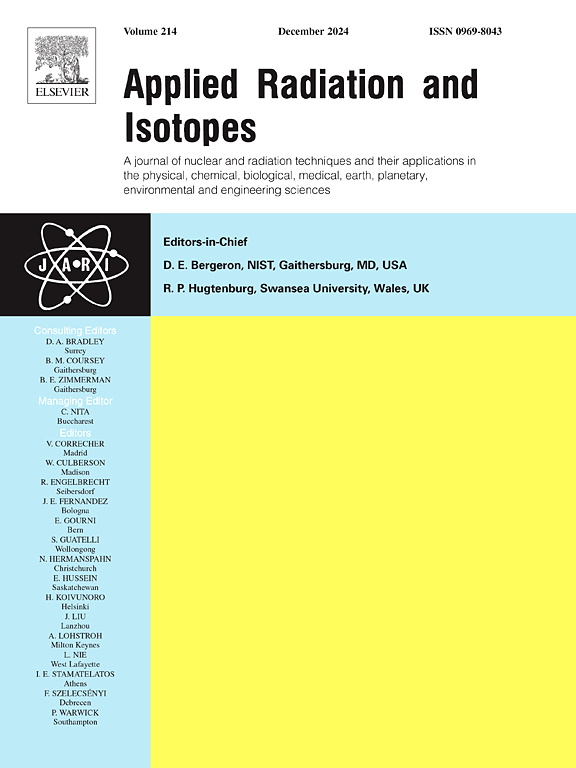伽马辐照在海水淡化中的应用
IF 1.6
3区 工程技术
Q3 CHEMISTRY, INORGANIC & NUCLEAR
引用次数: 0
摘要
提出了一种低剂量(1.0 kGy) Co-60源辐照海水淡化的方法。对于海水,该方法是基于室温下的实验室测量。研究了地中海(MS)海岸、红海(RS)海岸和氯化钠(NaCl)溶液的光学和电学特性。过滤后的MS在T = 10 ~ 95%时的曲线下面积分别为3.7 × 103、2.5 × 103和2.7 × 103,分别为0.0、0.1和1.0 kGy,而捕集水(TW)为1.3 × 103。在λ = 240 nm处采用多孔玻璃滤光片后,MS-1.0 kGy的折射率n和实部εr分别降至75%和63%。在1.0 kGy时,RS-0.0 kGy的电阻率提高了~ 6倍。在RS-1.0 kGy下,RS-0.0 kGy的相位角从53.0弧度减小到7.0弧度。这种使用低剂量伽玛辐射进行海水淡化的独特技术代表了一种新的应用,可以添加到其他方法中,也可以用于工业和农业等领域。本文章由计算机程序翻译,如有差异,请以英文原文为准。
Utilization of gamma-irradiation for seawater desalination
We present a method used for the seawater desalination with low doses of gamma irradiation (up to 1.0 kGy) emitted from Co-60 source. For seawater, the method is based on laboratory measurements at room temperature. The optical and electrical characterization of Mediterranean Sea (MS) coast, Red sea (RS) coast, and sodium chloride (NaCl) solution were investigated. Areas under curve at T = 10–95 % of MS were found 3.7 × 103, 2.5 × 103 and 2.7 × 103 at 0.0 kGy, 0.1 kGy and 1.0 kGy, respectively after filtration which were compared with trap water (TW) which were found to be 1.3 × 103. The refractive index, n, and the real part, εr, of MS-1.0 kGy, followed by porous glass filter at λ = 240 nm decreased to 75 %, and 63 %, respectively. The resistivity of RS-0.0 kGy was increased ∼6 times at 1.0 kGy. The phase angle of RS-0.0 kGy was decreased from 53.0 to 7.0 radian at RS-1.0 kGy. This unique technique of using low-dose gamma radiation for seawater desalination represents a novel application added to other methods, as well as to industrial and agricultural applications, etc.
求助全文
通过发布文献求助,成功后即可免费获取论文全文。
去求助
来源期刊

Applied Radiation and Isotopes
工程技术-核科学技术
CiteScore
3.00
自引率
12.50%
发文量
406
审稿时长
13.5 months
期刊介绍:
Applied Radiation and Isotopes provides a high quality medium for the publication of substantial, original and scientific and technological papers on the development and peaceful application of nuclear, radiation and radionuclide techniques in chemistry, physics, biochemistry, biology, medicine, security, engineering and in the earth, planetary and environmental sciences, all including dosimetry. Nuclear techniques are defined in the broadest sense and both experimental and theoretical papers are welcome. They include the development and use of α- and β-particles, X-rays and γ-rays, neutrons and other nuclear particles and radiations from all sources, including radionuclides, synchrotron sources, cyclotrons and reactors and from the natural environment.
The journal aims to publish papers with significance to an international audience, containing substantial novelty and scientific impact. The Editors reserve the rights to reject, with or without external review, papers that do not meet these criteria.
Papers dealing with radiation processing, i.e., where radiation is used to bring about a biological, chemical or physical change in a material, should be directed to our sister journal Radiation Physics and Chemistry.
 求助内容:
求助内容: 应助结果提醒方式:
应助结果提醒方式:


